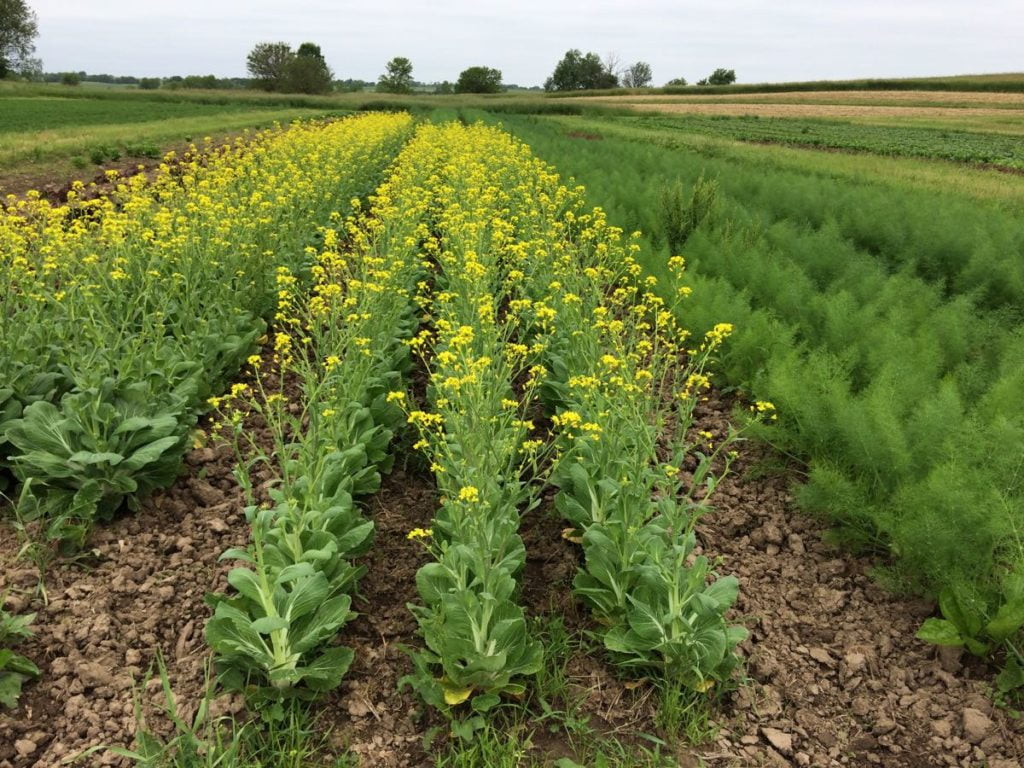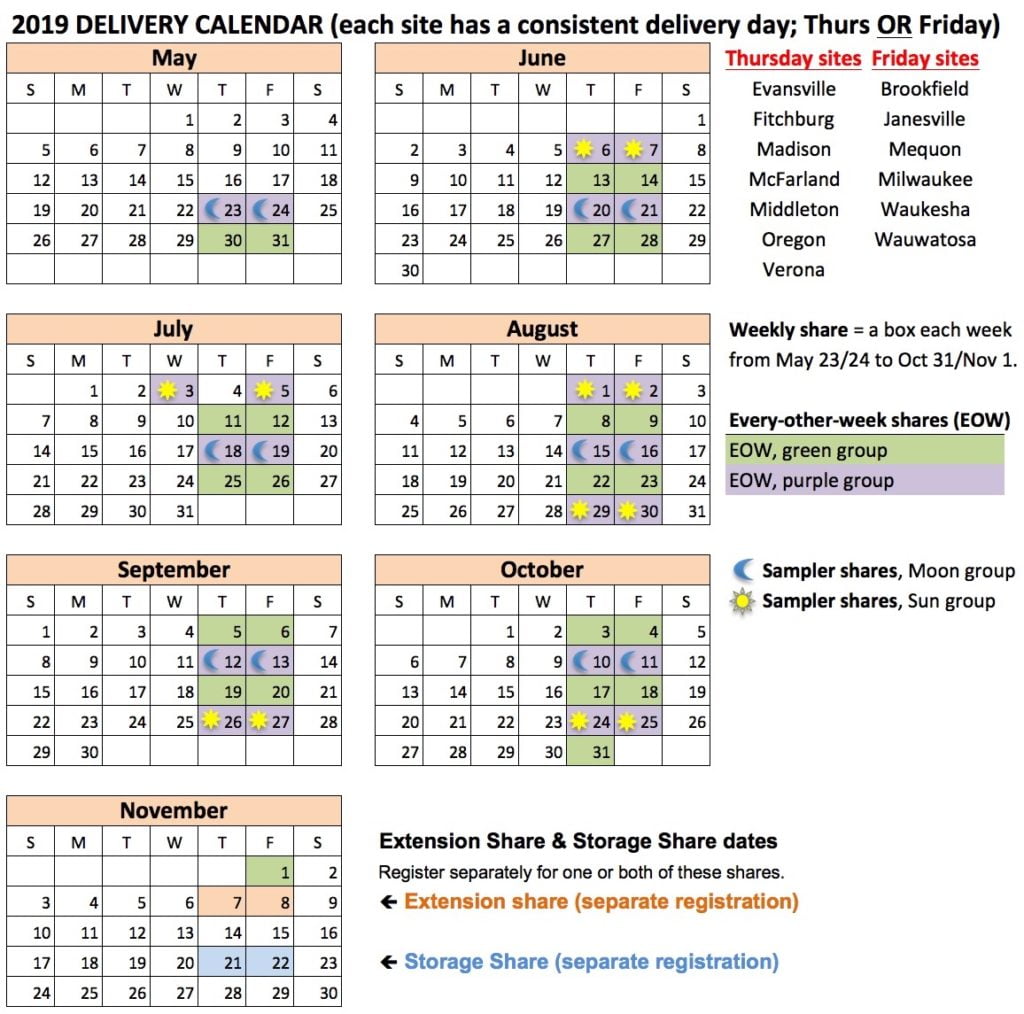Week #5, A Beeautiful Field
- On: June 19, 2019
 0
0
The bok choy we intended for last week’s CSA boxes flowered prematurely. It was disappointing but not unexpected following the temperature swings we’ve seen this spring. It’s been years since we lost an entire planting like this.
The plants are in full, glorious bloom, and we plan to keep them as long as possible. What value do they have now? The bok choy flowers are loaded with nectar and pollen, scarce commodities when few plants are blooming in spring. Beneficial insects and pollinators need food this time of year. Look at that field – it’s a smorgasbord. Walk in and it is filled with buzzing, frantic insects. I don’t get stung and haven’t observed territorial behavior. There’s enough food to share.
Happily, this is National Pollinator Week. Do the insects know?
I decided to identify species visiting these plants, to test our theory that a planting like this is valuable. I sent photos to P. J. Liesch of the UW Insect Diagnostic Lab. He was very helpful, even though exact identification wasn’t possible with photos.
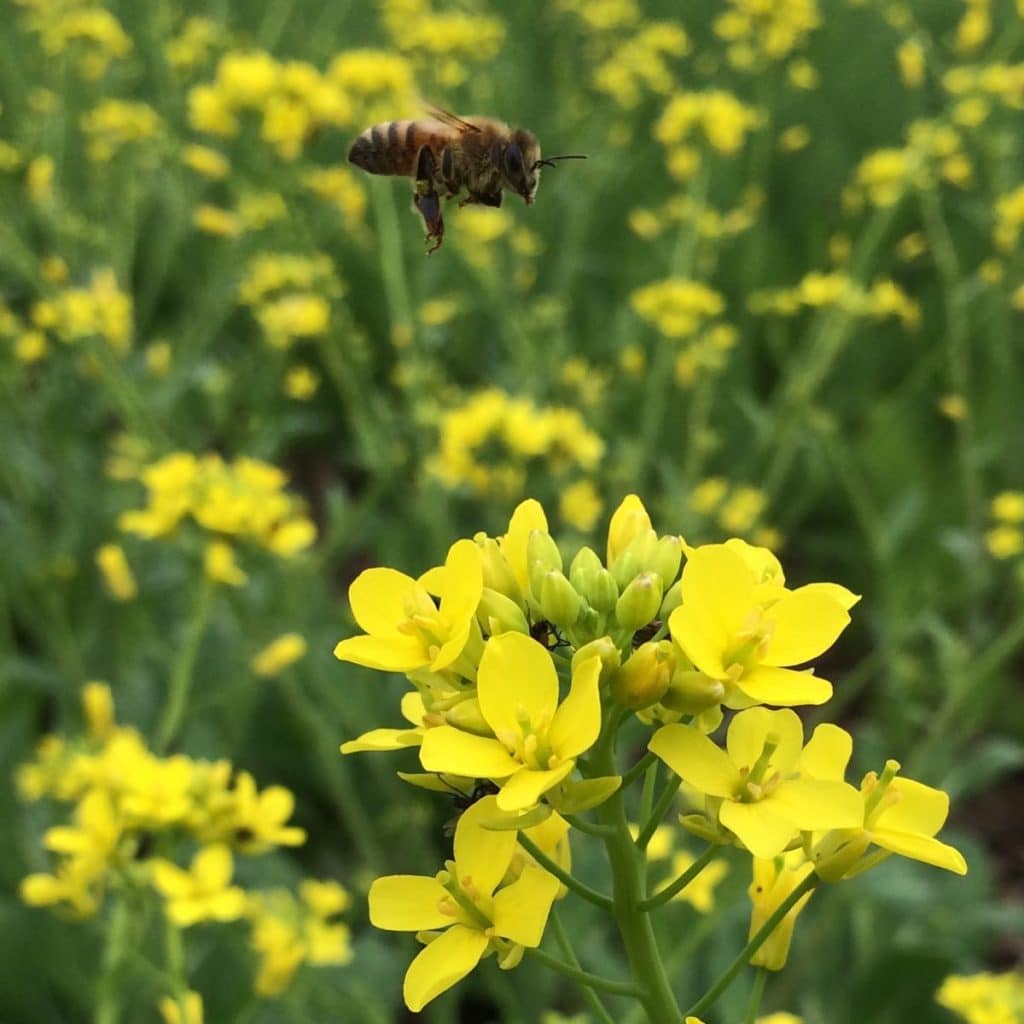
Honeybee, coming in for a landing.
We rent hives from a local beekeeper, to ensure pollination of crops like zucchini, cucumbers, etc. However, honeybees are not our only pollinators. Our strawberry field was loaded with wild bees during bloom this year, well before the beehives arrived. Good pollination increases strawberry yields so this is valuable.
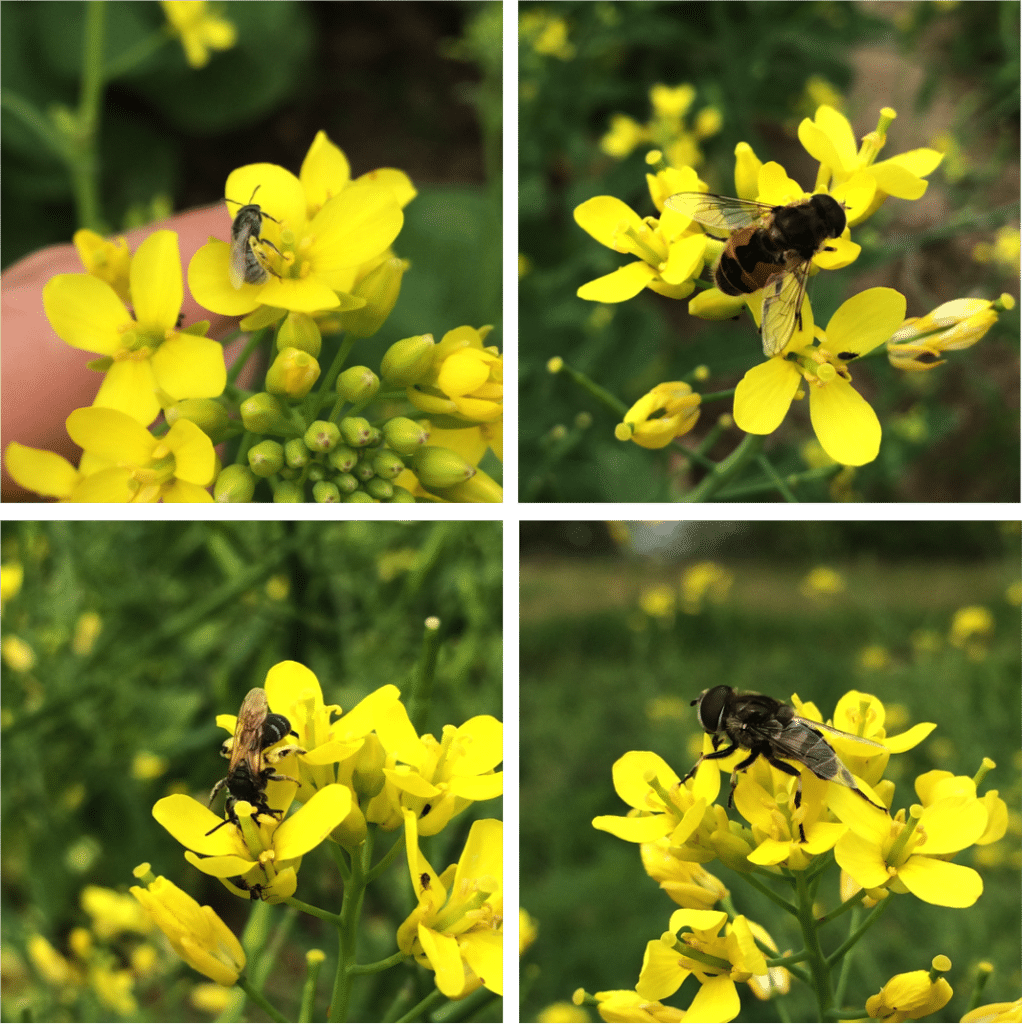
P. J. says the two insects on the left “are definitely wild bees of some kind. Spring often sees a spike in wild bee activity once flowers pop out.” Take a look at how much pollen each bee carries. The two insects on the right are likely types of hover flies, beneficial insects whose larvae eat tons of crop pests. These are all ‘good guys.’
For those interested, the top right insect “appears to be the European Drone Fly (Eristalis arbustorum) from the hover fly family or a very close relative. The adults go to a wide range of flowers.”
Bottom right “also looks like a hover fly. The general appearance and banding on the legs reminds me of some of the species from the genera Chalcosyrphus or Xylota.”
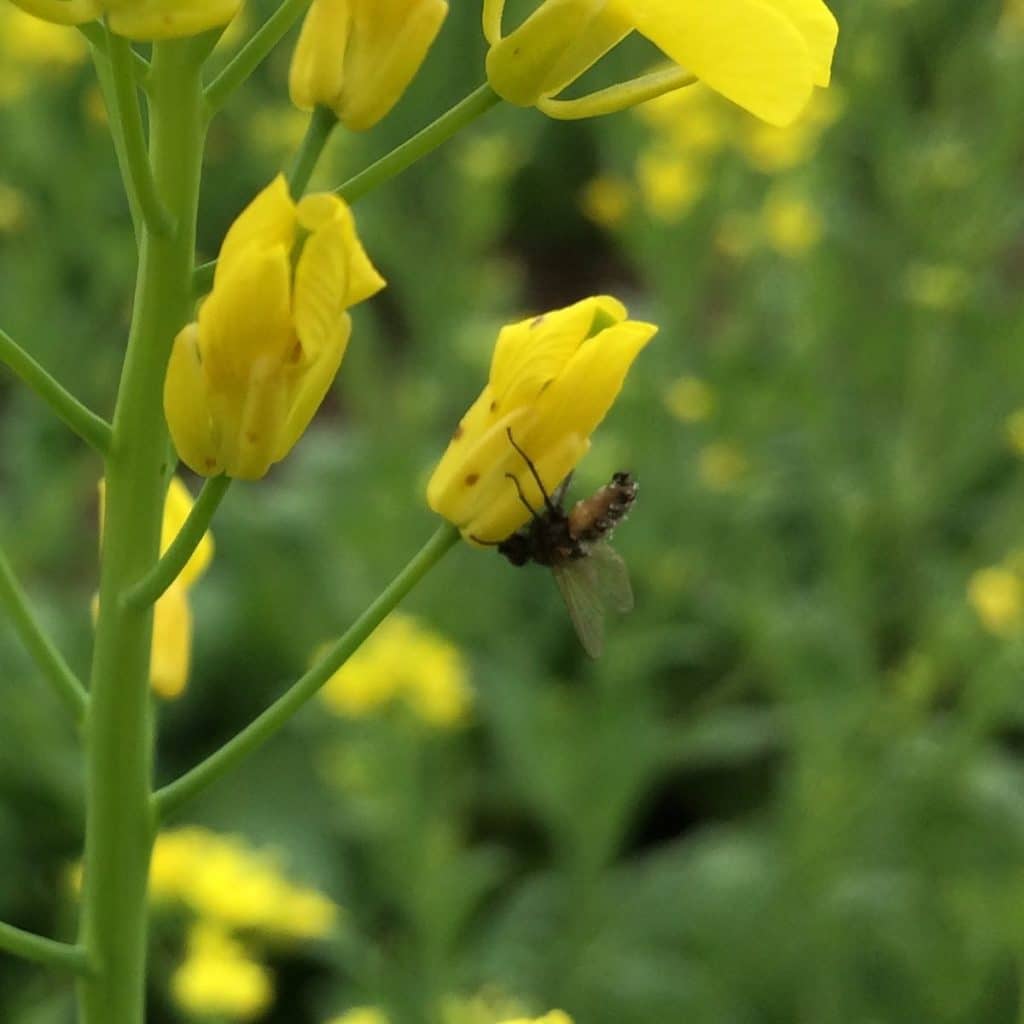
What about crop pests?
They are there, including flea beetles and cabbage maggots that damage radish and turnip roots. Take a look at the fly in this photo. It’s dead, handing upside down, glued to a flower at the top of the plant, and covered in fungal spores. P.J.: “Looks like a fly taken out by the Entomophthora fungus. Not too surprising given our rainy start to the growing season! Could be cabbage maggot or another Muscoid type fly.”
This fungus is so cool! We find infected flies like these in onions and in flowering brassicas, and appreciate any reduction in crop pests that results. Read an excellent and gruesome short article about Entomophthora here.
These photos show a fraction of the insects in the bok choy field, just a few of the ones slow enough to photograph. We are more than happy to keep this field intact. We’ll do the same throughout the season, allowing finished crops to flower for a few weeks. Building habitat for beneficial insects has become an important part of our farm. Thanks for reading and geeking out with me. Beth
Reminder, July 3 delivery for Thursday sites.
Let’s review our schedule during the July 4 holiday week.
– Thursday sites, we will deliver on Wed. July 3 to avoid the holiday. No changes in site hours. This affects Weekly EOW/purple, and Sampler/sun members.
– Friday sites, we will deliver on Friday July 5, as usual.
– Here is our calendar, in case that helps.
– Need to reschedule? Go here. Deadline = Sunday night before the week of delivery.
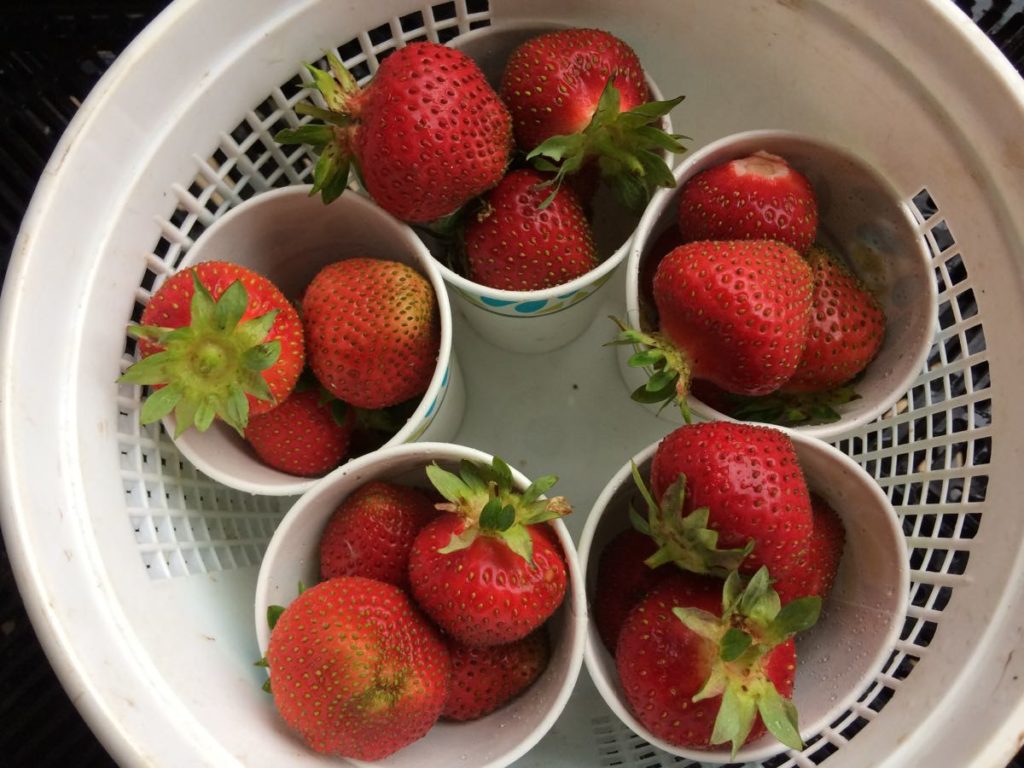
We have just enough strawberries for everyone to get a paper cup of berries. We picked these in the rain, which means they are perishable and you should eat them right away.
Veggie List and Veggie Notes
Week #5, June 20/21, 2019
– Weekly shares
– EOW/purple
– Sampler/moon
Strawberries, 1 paper cup
Sugar snap peas, ~1/2 lb
Zucchini, 2 to 2.5 lb
Napa cabbage
Spinach, 1 big bunch
Broccoli, ~ 1 lb
Lettuce, iceberg OR red leaf
White salad turnips, probably 2 – 3 big roots without greens
Scallions, 1 bunch
Next week’s box will probably contain strawberries, sugar snap peas, zucchini, spinach, lettuce, scallions, garlic scapes and more.
Sugar snap peas (plump pea pods) – These peas should be eaten pod and all. They are delicious raw, or very lightly cooked or stir-fried.
Preparation: They will need a quick rinse to remove faded gray blossoms.
Remove the strings before eating: snap off the stem end and pull the string down the concave side of the pod (the inward-curving side). Throw away the string and eat the pod.
Storage: Refrigerate.
Zucchini & summer squash – This is the first picking, so a few will be lumpy, the result of incomplete pollination while the plants were under row covers. Zucchini and summer squash need refrigeration but do not do well at very cold temperatures, as they will soften and form pits in their surface. Refrigerate these squash but in the warmest part of your fridge.
Napa cabbage (large, pale green cabbage with crinkled leaves) – This week’s napa might have an internal flower stalk, also the result of fluctuating temperatures this spring. Cut it lengthwise and you’ll find out. The stalks are still tender (and surprisingly sweet) so there’s no harm including them in your dishes.
Napa cabbage is an interesting vegetable, useful for both fresh, raw salads and for cooking. Its most famous use is fermented kimchi. I like to prepare a fresh, unfermented kimchi. Same seasonings, but it’s ready to eat right away. You will be amazed at how much shredded napa cabbage shrinks when prepared this way. See here for an example, but cut the salt in half (or less): Grilled Flank Steak with Kimchi-style Coleslaw.
Storage: Napa stores very well. Cut off wedges as needed and keep the rest covered and refrigerated, and it will keep for several weeks. Peel off the outer layer and it will be ready to use. Here are a few preparation ideas from the ‘Asparagus to Zucchini’ cookbook.
– Chop raw napa into green salads.
– Substitute napa in traditional coleslaw.
– Chinese cabbage cooks quickly. Steam 3-5 minutes, or until leaves are wilted down but remain slightly crisp.
– Substitute napa cabbage for common cabbage in recipes, but reduce the cooking time by 2 minutes.
– Napa cabbage is the main ingredient in egg rolls. Try making an egg roll mixture to eat as a cooked side dish instead of preparing time-consuming egg rolls.
Broccoli – Refrigerate in a plastic bag or a container. Make sure there’s no free water puddled in the bag or container, to avoid rot. It’s a bad idea to store broccoli uncovered in the fridge; it will wilt.
White salad turnips – This is our third delivery of white salad turnips. They are incredibly sweet this year. If you are tiring of them, check our Facebook discussion page. People are coming up with lots of creative ways to use the turnips. Also, Pat and Lauren have given us turnip recipes the past two weeks. Peruse the recipes in our 2019 Recipe Log.
Storage: Refrigerate in a bag or box. These keep quite well, now that the greens are removed. Should store without trouble for three to four weeks.
RECIPES
Visit our 2019 Recipe Log or our 2018 Recipe Log or join our Facebook discussion group.
LOCAL THYME/ Comforting Classics
Braised Napa Cabbage with Prosciutto
Beef and Vegetable Stir Fry
Spinach Gomae
Broccoli, Zucchini and Cabbage Curry
LOCAL THYME/ Outside the Box Recipes
Chickpeas and Veggies Makhani
Kimchi-Style Sauteed Cabbage
Warm Spinach Salad with Smoked Trout
Ground Turkey and Vegetable Lettuce Wraps with Peanut Hoisin Sauce
LOCAL THYME/ Quick & Easy Meal
Stir Fry of Snap Peas, Zucchini and Ground Meat atop a bed of Napa Cabbage
????
RECIPES FROM LAUREN
SPICY NAPA CABBAGE SALAD WITH TURNIPS & PEANUTS
Recipe adapted from Bon Appetit
Let me just begin by saying this recipe does not need to be spicy. It will only be spicy if you use the full amount of red pepper flakes but if you’re a person who knows they don’t like things with spicy in the title by all means leave them out or perhaps halve the amount called for.*
1 medium head Napa Cabbage, shredded (6-8 cups)
3 turnips, shredded (with a cheese grater) (approx 2 cups)
1/2 teaspoon Kosher salt, plus more to taste
Zest of 1 lime
2 tablespoons fresh lime juice
2 tablespoons rice wine vinegar or white wine vinegar (champagne or apple cider vinegar would both also work)
2 tablespoons white miso
1 tablespoon soy sauce (or tamari)
1 tablespoon fish sauce
1 teaspoon red pepper flakes (or less if you don’t like things spicy)
1/2 teaspoon sugar
2 tablespoons vegetable oil
4 scallions, ends trimmed and sliced
1/2 cup coarsely chopped salted, roasted peanuts
2 teaspoons black sesame seeds
- Toss cabbage, turnips and 1/2 teaspoon salt in a large bowl. Place in a colander to drain while you prepare the dressing. Pour out any liquid that remains in your bowl.
- Mix together lime zest, lime juice, vinegar, miso, soy sauce, fish sauce, and sugar in the large bowl you tossed the cabbage in earlier. Whisk until smooth and then slowly whisk in oil. Add cabbage and turnips back in along with scallions and toss to combine*.
- Serve salad topped with peanuts and season seeds.
*Feel free to also add sliced radishes from last week along with any herbs you have lying around (parsley, cilantro, or mint would all be welcome additions). You can also add thinly sliced snow or snap peas if you didn’t immediately devour them. If you want this to be more of an entree style salad you can consider adding some shredded chicken or turkey to the bowl as well!
.
????
.
GREEN MACHINE FRITTATA
2 tablespoons butter, olive oil or coconut oil, divided
1-2 zucchini, diced
1 pound broccoli, florets roughly chopped
2 scallions, sliced (white and pale green portions only)
1/2 teaspoon Kosher salt
1/4 teaspoon freshly ground black pepper
2 cups roughly chopped spinach
8 eggs
1/4 cup heavy cream or whole milk
1/2 cup favorite cheese, optional (I love feta or an aged Cheddar)
- Melt 1 tablespoon butter (or oil) in a large (at least 10 inches wide) non-stick or cast-iron skillet that is oven proof. Add zucchini, scallions and broccoli along with salt and pepper. Cook for 8-10 minutes over medium heat until broccoli is pretty tender and bright green.
- Add spinach to the pan and continue to saute veggies over medium heat until spinach has wilted. It will likely release some water. Don’t worry about this too much.
- In a large bowl whisk together eggs and cream. Using a spatula, remove the veggies from the pan and pour them into the egg bowl. Stir to combine. Wipe out the skillet with a towel and heat remaining tablespoon butter or oil over medium-low heat. Pour the egg/veggie mixture into the pan and sprinkle with cheese if using. Cook for 8-10 minutes over medium-low heat until the edges begin to firm.
- Meanwhile, preheat your broiler to low. Once frittata edges have begun to firm, transfer to the top rack of your oven and broil for 5-10 minutes (making sure to check after 5 minutes as every broiler has a different intensity level!) until the eggs are set and golden brown at the edges. Remove from the oven and allow to cool for 5 minutes before serving.
.

